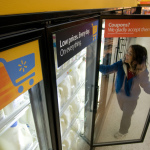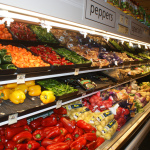
Does having more money mean we’re no longer interested in saving any money? A new survey says many of us aren’t bothering to look for coupons or deals the way we used to – and we don’t really miss them.
That’s according to the Retail Feedback Group’s 2015 U.S. Supermarket Experience Study. “As the economy is recovering, some shoppers are starting to abandon money-saving practices,” the study finds.
Across the board, the use of all manner of money-saving measures is down from last year’s survey. 86% of respondents said they consult the sales circular, down from a nearly universal 96%. 25% reported using paper coupons, down from 32% last year (and 35% the year before). And 14% use digital coupons, down from 19% (20% in 2013).
So did we all suddenly get rich? No, but those who are, may have decided that all that clipping and sorting isn’t really worth the trouble anymore. The decline in the use of coupons and sales circulars “is predominantly driven by higher-income shoppers, who are starting to re-emphasize convenience and speed,” the report finds.
And that’s not all they’re looking for in a grocery store. Shoppers said encountering knowledgeable employees, receiving exceptional service and being made to feel like a welcome guest in their store, were key determiners of their store satisfaction level. Yet, in reality, they complained they were more likely to encounter unhelpful employees who are never around when you need them. Other factors that made for a bad shopping experience were dirty stores, inaccurate price scans and “an unpleasant odor in the seafood department.”
So there’s more to a good shopping experience than just low prices. But getting good deals is still important to many shoppers – even though stores aren’t necessarily providing them. “As the economy is in recovery, stores are slowly but surely moving away from deep price promotions,” the report says. “Shoppers appear to recognize this, with the rating for promotional prices dropping.” 88% said they were satisfied with the prices on advertised sale items, down from 91% last year.
Meantime, 69% said they were okay with the regular prices on non-sale items. Rather than ramp up the sales and deals, the report suggests that stores focus on more attractive everyday prices.
Doing so could help convert cherry-pickers into regular shoppers. 13% of those surveyed said their most recent shopping experience was just to pick up a few items that were on sale – and they did the rest of their regular stock-up shopping somewhere else. Stores that ensure a better shopping experience – and better everyday prices – have a better chance of turning the deal-seekers into loyal customers.
But in the end, it doesn’t have to be either/or. Deal-seekers are among a store’s best customers, the report concludes. That runs counter to the conventional wisdom, that those who shop the sales are just cherry-picking opportunists who cost a store money. “Shoppers who use the circular, coupons and sales promotions are more satisfied and more likely to recommend the store,” the report finds, suggesting “a direct correlation between perceived value, pricing and sales promotions and willingness to recommend, trip satisfaction and higher spending.”
So fewer shoppers may be looking for deals. But those who are, have nicer things to say about their stores. Ultimately, “supermarkets must focus on getting the basics right,” the report recommends. “Whether cleanliness, friendliness, speed of service, odor or out-of-stocks,” stores that get the fundamentals wrong “run the risk of dissatisfying shoppers, losing out on the basket size, creating negative word-of-mouth dialogue, and ultimately, risking shopper defection.”
And then, shoppers who claim not to care about deals anymore, and those who still like looking for them, will all be doing their shopping somewhere else.











LOTS of fascinating nuggets in this report (and more to tease out) but I remain utterly dumbfounded by any firm’s willingness to draw sweeping conclusions based on the self-reported behavior of 1,200 people. (particularly when actual transaction data / industry data refutes the anecdotal accounts)
If anything, THAT’S the more compelling story for shopper marketing & research types: why is self-reported shopper behavior so often at odds with actual industry figures? (Do we want the survey administrator to like us, or think we’re cool?)
Just where is this so-called economic “recovery” taking place, I wonder?
I would guess the reason fewer people are using coupons is because a lot of people jumped on board during the “extreme couponing” days. I imagine a lot of them found that it took a greater time investment than they were willing to put into it long-term, or they simply hated doing it.
Sale prices are not as low as they used to be. The number of available coupons that bring the price of an item down to a reasonable cost are dwindling. Many people are finding that they can shop at stores like Aldi without the hassle of dealing with coupons. As prices have risen, I am learning to cook more and more things from scratch. I am more likely now to buy a whole chicken and cut it up myself, mix ground turkey or pork with ground beef to stretch it. I buy beef short ribs or soup bones instead of expensive stew meat. I am more likely to use fresh produce, dried beans, rice and other inexpensive, minimally processed foods to save money.
Maybe it’s just the part of the country I live in (the mid-south), but I have seen no signs of an economic recovery.